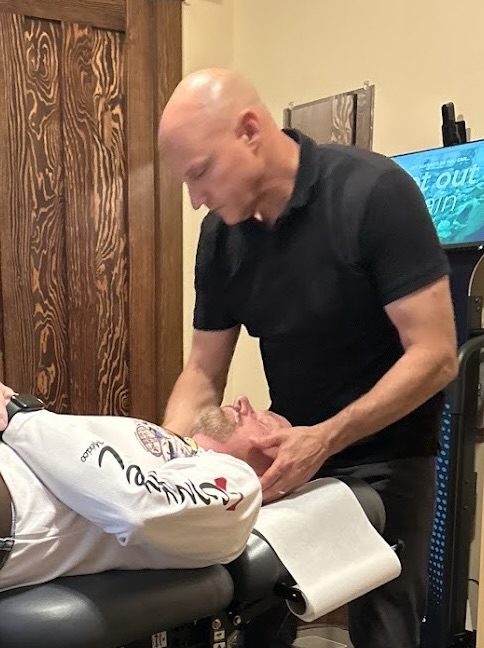Welcome to our blog! Today, we’re diving into a topic that often raises questions: the safety of chiropractic treatment. As a chiropractor in Edmonton, I understand the importance of addressing concerns about the safety of chiropractic care. It’s common for people to be scared of the “unknown”. So for some people, seeing a chiropractor for the first time can create some anxiety. A common question for someone who has never seen a chiropractor before would be, “Is chiropractic treatment safe?” Let’s explore this issue together and shed light on the facts.
Understanding Chiropractic Care
Chiropractic treatment focuses on restoring proper alignment, mobility, and function of the spine and nervous system. It’s based on the fact that the body has the innate ability to heal itself when provided with a heathy environment. So having a properly aligned spine and a nervous system that is working optimally would be part of that equation. Through manual adjustments and other techniques, chiropractors aim to achieve proper spine alignment and mobility, restore optimal function of the nervous system, alleviate pain, and enhance overall well-being.
Is Chiropractic Treatment Safe?
Research and studies consistently support the safety of chiropractic adjustments. While some may have concerns, it’s essential to understand that adverse effects are rare and typically minor, such as temporary soreness or stiffness. Compared to more invasive interventions like surgery or medication, chiropractic care poses minimal risk to patients. Let’s briefly talk about some of the concerns some people have about chiropractic adjustments.
Chiropractic treatment and strokes
While stroke cases linked to a variety of healthcare visits including chiropractic visits exist, evidence doesn’t confirm chiropractic care causes them. Extensive research on neck adjustments shows their safety. Studies consistently indicate minimal risk, affirming its safety. In fact, estimates of the risk of serious adverse events such as stroke ranged from 0.05 to 1.46 per 10,000,000 chiropractic adjustments (manipulations). (1)
In comparison, taking a common NSAID medication, like Advil or Ibuprofen, poses a much higher risk of developing a serious adverse event. For example, the incidence of clinically significant upper GI (gastrointestinal) bleeding in NSAID users has been estimated at 1-2.5/100 person-years. (2) Further, depending on the type of NSAID, the relative risk of getting a serious GI bleed is 1.9-5.6 times more likely when taking NSAIDS versus not taking them. (3, 4)
For more perspective, there is a risk of dying while carrying on regular activities of daily living. For example, the risk of dying when driving is 5 per 100,000 population (5) and choking to death while eating poses a 2.5 per chance of dying per 100,000. (6)
More pain after chiropractic treatment
Sometimes chiropractic adjustments cause a temporary worsening of symptoms that usually last from a few hours to a few days. This can happen due to a variety of factors like preexisting inflammation (eg. arthritis), disc problems, or the treatment was too aggressive. Make sure you discuss this with your chiropractor if this happens to you. Keeping an open lines communication will help you and your chiropractor determine why you are getting pain post treatment so that it might be avoided for subsequent treatments.
Scared of the “Cracking”? There are Alternatives
The “cracking” or “popping” sound you hear with many chiropractic adjustments is a result of gas released within the joints of the spine. So rest assure there are no bones breaking. As previously discussed, chiropractic adjustments are a very safe procedure. However, some patients still find the sound and quick movement of the manual chiropractic adjustments uneasy. To make some patients more comfortable, there are lighter adjustments that can be done either by pushing or pulling lighter with the hands or by using instruments that apply a lighter force to the spine. Make sure you keep an open lines of communication with your chiropractor if feel you would be more comfortable with lighter adjustments.
Expert Oversight and Regulation
In Canada, chiropractic practice is regulated by provincial regulatory bodies to ensure high standards of care and patient safety. In Alberta, the regulatory body for chiropractors is the College of Chiropractors of Alberta. Chiropractors undergo rigorous education and training, including a minimum of four years of undergraduate study followed by an additional four years at an accredited chiropractic college. This comprehensive training equips chiropractors with the knowledge and skills to provide safe and effective care.
Evidence-Based Practice
Chiropractors adhere to evidence-based practice, meaning they integrate the best available research with clinical expertise and patient values. Numerous studies support the efficacy and safety of chiropractic care for various conditions, including back pain, neck pain, headaches, and more. By staying up-to-date with the latest research, chiropractors can tailor treatments to meet the unique needs of each patient.
Patient Education and Informed Consent
Empowering patients with knowledge is key to ensuring informed consent. It’s essential for patients to understand the risks and benefits of chiropractic treatment, as well as any alternatives. Open communication between patients and chiropractors fosters trust and allows for collaborative decision-making. Patients are encouraged to ask questions, express concerns, and actively participate in their care.
Conclusion
In conclusion, chiropractic treatment is safe when performed by qualified professionals. As a chiropractor in Edmonton, I am committed to providing safe, effective, and personalized care to all my patients. If you have any questions or would like to learn more about chiropractic treatment, don’t hesitate to reach out. Your health and well-being are always our top priority.
For a healthy spine and nervous system, contact Edmonton chiropractor Dr. Dean Collins. Or book a consult and exam with him today.
To learn more about how chiropractor care can help you and your family, read Dr. Collins’ comprehensive guide to chiropractic care: Chiropractic Care for Everyone.
Sign up for our Dr. Collins’ newsletters and blog posts
Sign up Dr. Collins’ newsletters to receive vital information on how to keep your spine and nervous system healthy as well as how to help optimize your health and avoid chronic illness.



Leave a Reply